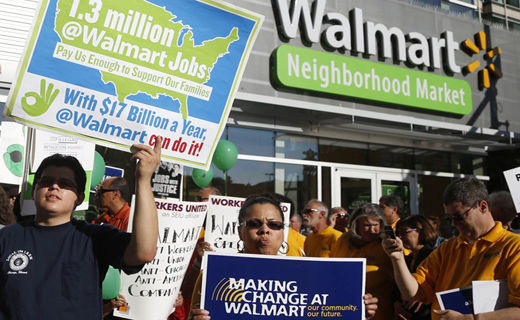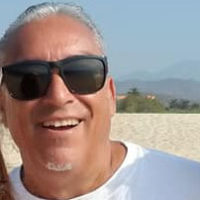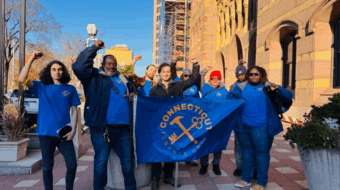
The following is from the Communist Party USA convention discussion website. David Trujillo is a member of the CPUSA National Labor Commission from Los Angeles. Under the slogan, “People and nature before profit,” the CPUSA met in Chicago June 13-15 for its 30th national convention. It was live streamed and parts broadcast on C-Span. Peoplesworld.org will continue to provide coverage. Join the conversation on Twitter #cpusa95 or on Facebook.
In 1934 West Coast Unionism was secured by the organizing efforts of the International Longshoreman’s Workers Union. After years of bloody battles the ILWU began to organize the once lowly regarded longshoreman’s work into a highly skilled profession. Many during the 1930s said that these workers could not be organized. The private shipping industry was too powerful, state and local government were against the workers, the police and private guards owned by the shipping companies were too violent and powerful. The longshoreman on the docks could not be organized. These workers did in fact organize.
In 1941 Henry Ford and the Ford Motor Company signed the first contract with the United Automobile Workers of America and the Congress of Industrial Organizations. Once again, many around the country said that these autoworkers could not be organized. They said that the company was too strong, had too much money and Henry Ford would never allow for his workers to be part of a union. It was a struggle. Many workers paid the price and there was much bloodshed. These workers did in fact organize.
Teachers were once thought too professional to be organized. Many teachers did not see the need for a union nor wanted to join a union. Teachers did in fact organize. Now teacher unions are some of most powerful organizations in the country. Organizations such as the American Federation of Teachers (AFT), the National Education Association (NEA), the California Teachers Association and the United Teachers of Los Angeles (UTLA), the California Faculty Association (CTA) and others promote trade unionism and advocate on behalf of teachers, children, and parents.
Physicians once thought of as having a culture of individualism never considered their profession as part of the traditional union movement. Now physicians are organized into the Doctors’ Council affiliated with the Services Employees International Union (SEIU); the Union of American Physicians and Dentists (UAPD) affiliated with the American Federation of State, County and Municipal Employees union (AFSCME). The Committee of Interns and Residents (CIR) is part of SEIU and represents interns, residents and fellows in states throughout the country.
Engineers and other professionals are organized. In Los Angeles for example the Engineers and Architects Association represents this professional group of workers. The University Professional and Technical Employees (UPTE) represent 17,000 University of California employees and are affiliated with the Communication Workers of America (CWA). The motion picture industry and the entertainment industry are represented by the Screen Actor Guild/American Federation of Television and Radio Artists (SAG/AFTRA), Actors Equity Association, and International Alliance of Theatrical Stage Employees (IATSE) as well as other unions. These professional workers did in fact organize and continue to organize.
Every major sport organization has a relationship with the trade union movement. This includes the Major League Baseball Players Association, the Major League Soccer Players Union, the National Basketball Player’s Association, and the National Football League Players Association. Even the referees in all the major sports have their associations.
There are of course many other unions and associations. I have just cited a few to give an overall example of the kinds of professional organizing taking place throughout the country. The successful organizing of these workers is based on the labor movement’s tactic of adopting a prolonged struggle within certain industries in an effort to win worker loyalty and commitment for fairness, equity and having a voice in the workplace. Unions have used their organizing efforts as a means to understand that technology and professional occupations are changing and as a result unions need to change their organizing approach.
This trend of organizing must continue if labor is to mount a successful counter-offensive to the right-wing and corporate attacks upon union members and the labor movement as a whole. According to the Department of Labor, over 3 million professional and technical employees participate in collective bargaining organizations. Today 51 percent of all union members are white-collar workers. This is a good sign.
The bad news for the labor movement is that many professional and highly skilled workers still view themselves as alienated from the labor movement. In many cases these workers consider unions irrelevant and unnecessary. This is a perspective that perpetuates the myth of the “un-organizable.” This is a serious problem that needs to be rectified if the labor movement wants to continue to have success in this area of organizing. The positive news is that professional workers provide a base for which organizing can continue to take place with potential growth.
Labor has been successful in organizing professional and highly skilled workers but there is much work to be done. If labor is to be relevant it must organize the three pillars of workers. low wage workers, professional and highly skilled workers, and in this age of globalization, workers internationally cross-border. This is where the growth is in organizing.
Some questions for consideration regarding organizing professional and highly skilled workers: Are unions viewed as outdated organizations that no longer have a vital function to perform? Is the decline of the labor movement symptomatic of a terminal condition? Can unions be rejuvenated if they modernize their organizing techniques? Can unions develop organizing campaigns that will engage these workers? Is organizing tech workers and other highly skilled workers an elusive goal for labor?
I now hear the same rumblings. Technical workers and other high skills professional workers (i.e., Silicon Valley) can’t be organized. This remains to be seen but history is on our side.
Photo: Charles Rex Arbogast/AP










